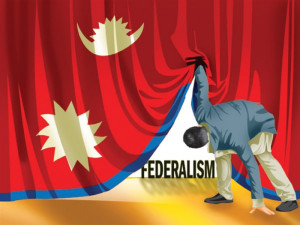Columns
Budget-making through a federal lens
Finance minister has the opportunity to reshape the budget in line with federal principles.
Khim Lal Devkota
The budget session of the federal parliament commenced on Friday, April 25. This session holds immense importance as it finalises the federal budget and passes associated financial bills. It also addresses legislative gaps in the federal system. Moreover, it offers an opportunity to align budgetary practices with the principles of federalism enshrined in the constitution.
Although the annual appropriation bill naturally gets the spotlight, it is equally important to address other pending legislative instruments that shape the fiscal and administrative architecture necessary for the effective implementation of federalism. For instance, legislations such as the Civil Service Act, the School Education Act and the Police and Security laws have a direct impact on the functioning of federalism within the broader federal framework.
So, it is necessary to reflect on improvements to budget formulation from a federalism perspective and to ensure that the principles of federalisation, subsidiarity and intergovernmental cooperation are respected in both policy and practice.
The foundation of an effective federal budget lies in the clear delineation of jurisdiction among the three tiers of government. It has been over a year since the Office of the Prime Minister and Council of Ministers finalised the unbundling exercise. This delay undermines the very foundation of federalism. This important exercise is aimed at assigning and clarifying the responsibilities and competencies of the federal, provincial and local governments. However, despite its completion, the report remains pending at the political committee level.
The Special Parliamentary Federalism Committee had recommended the publication and implementation of the revised unbundling report as its first priority. It is imperative that this report be endorsed without delay and used as a guiding tool for the preparation and execution of the budget. Without clarity on functions, the planning and budgeting processes will continue to suffer from overlapping responsibilities, inefficiencies and jurisdictional confusion.
Another recurring challenge is the federal government’s tendency to overreach and involve itself in areas that constitutionally fall within the domain of provincial and local governments. As provisioned by the constitution, the principle of subsidiarity—a cornerstone of federalism—stipulates that public functions should be handled by the lowest level of government capable of doing so effectively. But in practice, the federal government continues to retain control over numerous functions and programmes better suited for subnational authorities.
The Cabinet had previously endorsed a policy requiring the federal government to implement only “national pride projects,” “strategic game-changer projects,” and projects above a minimum threshold of Rs30 million. However, this policy has not been followed. Despite repeated commitments from both the prime minister and the finance minister to respect federal boundaries, smaller projects continue to be executed from the federal level, often bypassing provincial and local governments. This undermines local and provincial autonomy and weakens the entire federal structure.
The new budget must address this issue and ensure the federal government limits itself to national-scale interventions, transfering all subnational responsibilities to the respective levels.
Reforms in fiscal transfer
Reforms in the system of fiscal transfers are equally important. The financial capacity of provincial and local governments depends largely on the structure and predictability of grants from the federal government. Currently, there is a mismatch between the allocation of functions and the distribution of resources. More concerning is the increasing dominance of conditional grants, which now account for approximately 67 percent of the total grants received by local governments. This restricts the autonomy of subnational units, preventing them from designing programmes that respond to their local contexts.
The trend of declining equalisation grants—both as a share of GDP and the national budget—must be reversed. Equalisation grants are essential for ensuring that all levels of government can provide basic public services, regardless of their own-source revenue capacity. The upcoming budget should increase the proportion of fiscal equalisation grants and guarantee their stability. Moreover, the recent practice of the Ministry of Finance cutting equalisation grants after they have been approved by Parliament is a direct violation of the principle of financial certainty enshrined in the constitution. Such practices must be discontinued immediately to restore trust in fiscal federalism.
In line with this, the current model of allocating conditional grants also needs to be revisited. Both the Federalism Special Committee and the National Natural Resources and Fiscal Commission have suggested that conditional grants should be provided in a lump sum for broader sectoral objectives with clearly defined outputs and outcomes, rather than itemised activity-based allocations.
The role of the federal government should be limited to setting broad national goals and monitoring performance, while the design and implementation of specific programmes should be left to subnational authorities.
Rationalising federal structure
The size and structure of the federal government itself needs critical examination. Despite the constitutional transition to federalism, the federal bureaucracy has remained largely unchanged. Many ministries and departments that no longer have direct service delivery responsibilities continue to exist and consume a significant portion of the national budget. Rationalising the federal structure by eliminating redundant institutions would not only lead to cost savings but would also signal the government’s genuine commitment to federal principles. The saved resources could then be redirected to provinces and local governments where the majority of public services are actually delivered.
At the same time, coordination among governments remains weak and underdeveloped. Although the Inter-Provincial Council and the National Coordination Council exist on paper, they have not been effectively operationalised. These mechanisms must be activated through regular meetings, binding decisions and the establishment of a permanent secretariat. Similarly, sectoral committees and provincial coordination councils should be empowered to resolve disputes and facilitate joint planning, budgeting and mutual coordination. Without institutionalised intergovernmental relations, federalism will remain fragmented and uncoordinated.
A severe shortage of administrative and technical personnel continues to cripple subnational governments. In over 200 local levels, the Chief Administrative Officer position is filled only on an acting basis, and many wards lack basic staff, hindering citizens’ access to essential services like citizenship certification and passport recommendations. The federal government must introduce a systematic, fair mechanism to deploy human resources in bulk to provincial and local levels. The current practice of lobbying federal ministries for staff is inefficient and undignified.
Parallel institutions and mechanisms created by the federal government, often under donor-funded projects, further complicate governance. These structures duplicate efforts, waste resources and undermine the authority of elected subnational governments. They must be discontinued in favour of coordinated capacity-building initiatives.
Following the restructuring of local governments, particularly in mountainous and hilly regions, many now cover vast geographic areas, making service delivery challenging. Targeted programmes—such as mobile service units, additional service centers and improved transport infrastructure—are necessary to ensure equitable access. The budget must also account for these geographic challenges.
Public trust in federalism, especially regarding provincial governments, has weakened in recent years. Confidence must be rebuilt by promoting success stories, publishing good practices and highlighting tangible benefits. Provincial governments must also strengthen governance, ensure transparency and build capable institutions. Provinces remain fiscally and institutionally weak. They must be empowered through enhanced revenue powers, stronger administrative systems and targeted capacity building. The federal government should support, not bypass, provincial initiatives.
In conclusion, the finance minister can reshape the federal budget in line with federal principles, particularly by respecting the rights of provincial and local governments. Beyond financial allocations, real progress requires institutional reforms, legislative clarity and strong political will. Concrete actions to empower all levels of government will bring decision-making closer to the people and strengthen the federal democratic republic.




 12.12°C Kathmandu
12.12°C Kathmandu
.jpg&w=200&height=120)












%20(1).jpg&w=300&height=200)

